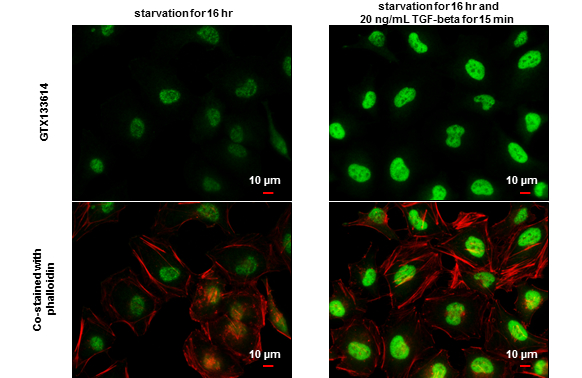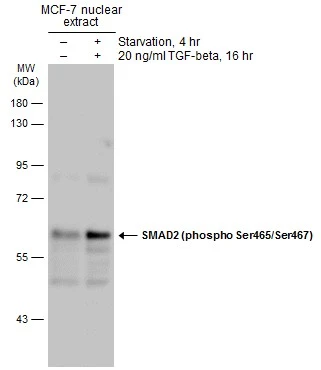
SMAD2 (phospho Ser465/Ser467) antibody detects SMAD2 (phospho Ser465/Ser467) protein at nucleus by immunofluorescent analysis. Sample: Mock and treated HeLa cells were fixed in 4% paraformaldehyde at RT for 15 min. Green: SMAD2 (phospho Ser465/Ser467) stained by SMAD2 (phospho Ser465/Ser467) antibody (GTX133614) diluted at 1:1500. Red: phalloidin, a cytoskeleton marker, diluted at 1:100. Scale bar= 10 μm.
SMAD2 (phospho Ser465/Ser467) antibody
GTX133614
ApplicationsFlow Cytometry, ImmunoFluorescence, Western Blot, ImmunoCytoChemistry
Product group Antibodies
ReactivityHuman, Mouse
TargetSMAD2
Overview
- SupplierGeneTex
- Product NameSMAD2 (phospho Ser465/Ser467) antibody
- Delivery Days Customer9
- Application Supplier NoteWB: 1:500-1:3000. ICC/IF: 1:100-1:1500. *Optimal dilutions/concentrations should be determined by the researcher.Not tested in other applications.
- ApplicationsFlow Cytometry, ImmunoFluorescence, Western Blot, ImmunoCytoChemistry
- CertificationResearch Use Only
- ClonalityPolyclonal
- Concentration0.44 mg/ml
- ConjugateUnconjugated
- Gene ID4087
- Target nameSMAD2
- Target descriptionSMAD family member 2
- Target synonymsCHTD8, JV18, JV18-1, LDS6, MADH2, MADR2, hMAD-2, hSMAD2, mothers against decapentaplegic homolog 2, MAD homolog 2, SMAD, mothers against DPP homolog 2, Sma- and Mad-related protein 2, mother against DPP homolog 2
- HostRabbit
- IsotypeIgG
- Protein IDQ15796
- Protein NameMothers against decapentaplegic homolog 2
- Scientific DescriptionThe protein encoded by this gene belongs to the SMAD, a family of proteins similar to the gene products of the Drosophila gene mothers against decapentaplegic (Mad) and the C. elegans gene Sma. SMAD proteins are signal transducers and transcriptional modulators that mediate multiple signaling pathways. This protein mediates the signal of the transforming growth factor (TGF)-beta, and thus regulates multiple cellular processes, such as cell proliferation, apoptosis, and differentiation. This protein is recruited to the TGF-beta receptors through its interaction with the SMAD anchor for receptor activation (SARA) protein. In response to TGF-beta signal, this protein is phosphorylated by the TGF-beta receptors. The phosphorylation induces the dissociation of this protein with SARA and the association with the family member SMAD4. The association with SMAD4 is important for the translocation of this protein into the nucleus, where it binds to target promoters and forms a transcription repressor complex with other cofactors. This protein can also be phosphorylated by activin type 1 receptor kinase, and mediates the signal from the activin. Alternatively spliced transcript variants encoding the same protein have been observed. [provided by RefSeq]
- ReactivityHuman, Mouse
- Storage Instruction-20°C or -80°C,2°C to 8°C
- UNSPSC12352203
References
- Chiou WC, Huang GJ, Chang TY, et al. Ovatodiolide inhibits SARS-CoV-2 replication and ameliorates pulmonary fibrosis through suppression of the TGF-β/TβRs signaling pathway. Biomed Pharmacother. 2023,161:114481. doi: 10.1016/j.biopha.2023.114481Read this paper
- Terasaki M, Inoue T, Murase W, et al. A Fucoxanthinol Induces Apoptosis in a Pancreatic Intraepithelial Neoplasia Cell. Cancer Genomics Proteomics. 2021,18(2):133-146. doi: 10.21873/cgp.20248Read this paper
- Terasaki M, Takahashi S, Nishimura R, et al. A Marine Carotenoid of Fucoxanthinol Accelerates the Growth of Human Pancreatic Cancer PANC-1 Cells. Nutr Cancer. 2022,74(1):357-371. doi: 10.1080/01635581.2020.1863994Read this paper
- Chen HY, Chou HC, Ho YJ, et al. Characterization of TGF-β by Induced Oxidative Stress in Human Trabecular Meshwork Cells. Antioxidants (Basel). 2021,10(1). doi: 10.3390/antiox10010107Read this paper
- Ye J, Lei J, Fang Q, et al. miR-4666-3p and miR-329 Synergistically Suppress the Stemness of Colorectal Cancer Cells via Targeting TGF-β/Smad Pathway. Front Oncol. 2019,9:1251. doi: 10.3389/fonc.2019.01251Read this paper










